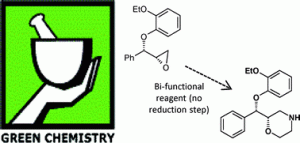In this article the Pfizer Green Chemistry metrics program is described and, as an example of its implementation, a case history of the synthesis of (S,S)-reboxetine succinate is presented. The environmental (and cost) improvements that were achieved through process development and synthetic route design coupled with rigorous measurement and analysis of Green Chemistry metrics are presented.
 (±)-Reboxetine mesylate is a selective norepinephrine uptake (NRI) inhibitor which is marketed as the racemate under the trade name Edronax for the treatment of depression. The (S,S)-enantiomer has undergone clinical evaluation as the succinate salt for a number of indications in the pain therapeutic area.
(±)-Reboxetine mesylate is a selective norepinephrine uptake (NRI) inhibitor which is marketed as the racemate under the trade name Edronax for the treatment of depression. The (S,S)-enantiomer has undergone clinical evaluation as the succinate salt for a number of indications in the pain therapeutic area.
The initial route of synthesis to (S,S)-reboxetine succinate used a classical resolution approach and generated high levels of waste. This route was replaced by an enantiospecific synthesis using Sharpless epoxidation chemistry, an enzymatic process to selectively protect a primary alcohol and a new efficient method of chiral morpholine construction as key steps.
These improvements reduced the levels of waste produced by more than 90%. This article describes a useful and instructive example for all scientists working in the area of green chemistry.
This article is free to access until the 30th November 2011! To read more, please click the link below…
The use of environmental metrics to evaluate green chemistry improvements to the synthesis of (S,S)-reboxetine succinate
Georges Assaf, Graham Checksfield, Doug Critcher, Peter J. Dunn, Stuart Field, Laurence J. Harris, Roger M. Howard, Gemma Scotney, Adam Scott, Suju Mathew, Geoffrey M. H. Walker and Alexander Wilder
Green Chem., 2011, DOI: 10.1039/C1GC15921F










